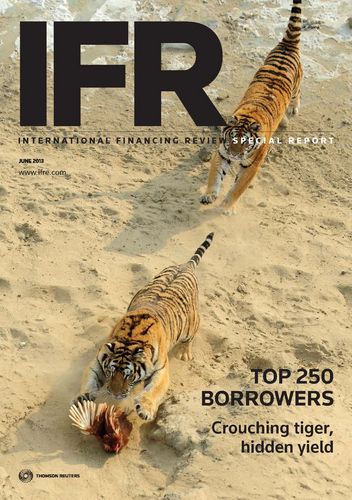The past year has been characterised by spread-tightening across the credit spectrum. This has left investors scrambling for yield in a low-rate, low-return market, with a few changing the way they viewed their mandates.
To view the digital version of this report, please <a onclick="window.open(this.href);return false;" onkeypress="window.open(this.href);return false;" href="http://edition.pagesuite-professional.co.uk/Launch.aspx?EID=8aa3f3de-df4c-4d35-b718-dd08452dc6e4">click here</a>.
To purchase printed copies or a PDF of this report, please email gloria.balbastro@thomsonreuters.com
In such a scenario, high-yield and emerging market debt were two beneficiaries - both running at a record pace - while portfolio managers were also willing to either go for longer maturities or further down the capital spectrum in their previously preferred credits.
This was coupled with a renewed interest in peripheral countries; with Ireland and Portugal finding the syndicated route reopened and even talk of Greece returning.
Corporates from the wider periphery found an even more willing audience as investors viewed them as offering incremental yield given their provenance, but still representing a relatively safe option as a result of a proportion of their cash being generated overseas. At the lower end of the European sovereign scale, Slovenia offered a case in point of the extent to which investors have modified their stance. In May, the Republic sold US$3.5bn of paper across five and 10-year tranches, attracting a US$16bn order book. This was despite having to stop the process halfway through after being hit with a downgrade by Moody’s, only to return at the same levels and see the paper fly out of the door.
Some 88% of the allocations went to real-money accounts, a telling demonstration that it was not just speculative money being put to work lower down the ratings scale.
Various quantitative easing initiatives kept the lid on many mainstream government bond yields and, consequently, credit markets. Fund managers in need of incremental yield had to look further afield than their traditional hunting grounds. In the corporate world, the highest of high-grade were not without opportunities, especially if they offered exposure to something new. The most notable example was debutant Apple, whose US$17bn blockbuster in April took advantage of benign bond market conditions to raise cash to return to shareholders. If it was an extreme instance in terms of size, it was not alone, with a swathe of other companies treading a similar path.
But the availability of cheap cash did not translate into a surge in M&A activity, with high valuations following a surge in equity markets persuading potential predators to keep their powder dry.
Bank lending was still available, although it was largely the strategically important - and therefore larger - companies that benefited.
But as one door closes, another opens; and as far as SMEs were concerned - albeit more the ‘M’s than the ‘S’s - the bond market stepped into the breach, with end-investor needs compensating for bank reticence.
In signs of an even deeper market rehabilitation, the moribund CLO market in Europe began to show early signs of returning to life. However, there are potentially serious obstacles to further growth: a lack of available loans and compressed spreads.
But evidence of the market’s fragility emerged as this report was going to press, as a spike in US Treasury yields on fears of a Fed tapering of QE sent prices tumbling. This was most felt in the higher beta segments, those very areas to which investors had been drawn in their hunt for yield.
So, some are now nursing nasty mark-to-market losses in unfamiliar territory, in addition to having to operate in what is still historically a low-yield environment.
No one said it was going to be easy.
